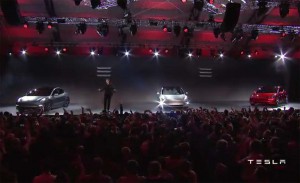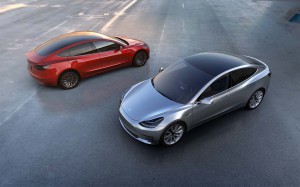
Tesla CEO Elon Musk in front of an image of the Model X SUV - which has been plagued by quality problems since its launch last year.
Struggling to solve quality problems with its first two models while getting ready to launch the all-new Model 3, Tesla Motors rolled up another deficit for the first quarter of 2016, but the losses narrowed, taking industry analysts by surprise.
The battery-electric automaker said it went $282 million into the red for the first three months of the year, or $2.13 a share. Excluding one-time items and using so-called non-GAAP accounting, the lose shrank to $75 million, or 57 cents a share, which was better than Wall Street had forecast, according to a survey of analysts by S&P Global Market Intelligence.
Finances were all but the secondary topic during a teleconference featuring Tesla founder and CEO Elon Musk and other senior executives. Much of the session focused on the upcoming Model 3 launch as well as efforts needed to resolve Tesla’s ongoing quality and reliability issues.
That, said Musk, “is the key thing we need to achieve in the future.” While he insisted Tesla “has done a good job on technology and design of our products,” he acknowledged quality has been an issue. “It’s the thing we’re going to need to solve and solve rapidly.”
(Tesla claims it has developed a bio-defense mode for its battery-cars. Click Here for the story.)
Tesla’s quality issues have been a subject highlighted on numerous blog and web posts, and the traditionally supportive Consumer Reports magazine hammered at that issue, last year revoking the Recommended Buy rating of the Model S, and more recently highlighting significant issues with the newer Model X.
That has raised concerns about Tesla’s ambitious plans to go mainstream with the Model 3, a $35,000 battery-electric sedan expected to yield at least 200 miles per charge.
Though the Model X was roughly two years late to market, CEO Musk asserted that the Model 3 will hold to its retail launch during the second half of 2017. In fact, he said, the goal is to roll as many as 200,000 of the compact battery sedans out of the Fremont, California assembly plant during the second half of next year.
If anything, said Musk, “We’re advancing the Model 3 plan substantially,” with the goal of reaching a production target of 500,000 vehicles annually by 2018, “instead of 2020,” as was originally announced.
This year, the CEO said, Tesla expects to produce about 89,000 Model S sedans and Model X SUVs. After a slow start, the carmaker has said that it has finally gotten the battery-ute up to its planned production speed. That is slightly less than some had been hoping for, averaging less than the 1,800 weekly estimate Musk laid out late last year. But the exec said the maker could be up to 2,000 vehicles a week by mid-year.
During the first quarter, sales of those two vehicles, along with other operations – such as its new battery storage unit, generated revenues of $1.15 billion. That was up from $939 million a year earlier.
Tesla has been shaking up its senior ranks, a new director of manufacturing stepping in as Tesla moves towards what could readily be called a rendezvous with destiny. Musk and his team have been leaning hard on suppliers, some of whom missed critical targets that led to Model X’s unexpectedly slow launch – and quality issues.
A target date for all suppliers, as well as the Tesla factory, to be ready for the Model 3 is July 1, 2016, said Musk, though he readily admitted volume production won’t begin quite that early. “The reality is that volume production will (begin) some months later.”
Musk said he was nonetheless confident enough to encourage potential buyers to make reservations now and expect they will be able to take delivery of a Model 3 sometime in 2018.
(Tesla purges Model 3 reservation list to get rid of speculators. Click Here for the story.)
Tesla took about 325,000 reservations during the first week after the March 31st unveiling of the new model, and the total is now up and above 400,000. Though non-binding, with a $1,000 deposit refundable, Tesla has reason to want as many reservations as possible. The company has taken in over $400 million so far which it can use to help support the steep capital outflow on product development.
Even then, Musk told analysts and reporters, “It may make sense for is to raise some capital through a combination of equity and debt to have a cash bumper on hand.”
Asked about longer-term production plans, Musk said the company has made no decision about adding more factories though, if demand hits Tesla’s goals it could need more than one plant just to satisfy North American demand. As for overseas, he stressed that “Manufacturing cars in California and shipping them around the world…isn’t an efficient way to go,” especially as Tesla launches new, lower-price models.
Longer-term, it would make sense, he suggested, to have factories in Europe, China, “and plants in other parts of the world.”
Tesla stock tumbled by 4.2% on Wednesday, to $222.56 a share, but it rebounded sharply after the earnings were released, picking up more than 5% by the time the after-hours news conference wrapped up.
(Even luxury maker Bentley is looking at its battery-electric options. Click Here for the story.)


